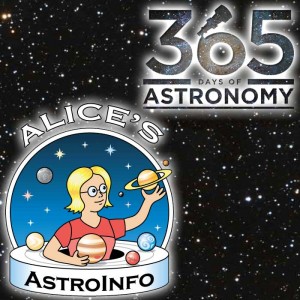Podcaster: Alice Enevoldsen aka Alice’s AstroInfo
 Title: What’s Up Tonight! Southern Skies January 2015 Edition
Title: What’s Up Tonight! Southern Skies January 2015 Edition
Organization: Alice’s AstroInfo
Link : www.alicesastroinfo.com
Heavens-Above Starcharts for anywhere, anytime, not installation required
Stellarium Free planetarium-style program for your computer or tablet
7Timer – Clear sky charts (will it be clear enough for stargazing?). Input your location, then click on “ASTRO” in the pop-up.
Description: Presented as a counterpart to Awesome Astronomy’s Northern Hemisphere monthly forecast, Alice talks about what’s visible from the Southern Hemisphere. Focused at about 33°S, this forecast should work for anywhere between 25°S and 50°S
Bio: Alice Enevoldsen currently volunteers as one of NASA’s Solar System Ambassadors. She has been working in planetariums since 1996, has a B.A. in Astronomy-Geology from Whitman College, and a Masters in Teaching from Seattle University. Her fascination with the stars led her to try her hand at astronomy research in Boston and Walla Walla, where she realized that her calling in life was actually to work in outreach and be a translator for scientists. Now she works hard to share her love of the stars and excitement about astronomy with as many people as possible.
Today’s sponsor: This episode of “365 Days of Astronomy” is sponsored by — no one. We still need sponsors for many days in 2015, so please consider sponsoring a day or two. Just click on the “Donate” button on the lower left side of this webpage, or contact us at signup@365daysofastronomy.org.
Transcript:
Hello, I’m Alice Enevoldsen, coming to you not-so-live from Alice’s AstroInfo with a podcast about what’s up in the January 2015 skies … over the Southern Hemisphere.
How are you today? … oh thanks, Happy New Year to you too!
Let’s start today with some Notable Sky Objects and Events in January.
Throughout January Comet Lovejoy (C/2014 Q2) is moving from Lepus through to Taurus, pretty much directly overhead throughout the evening. It should be about 4th magnitude in the middle of the month, which is bright enough to see naked eye on a decent night unless you have a ton of light pollution.
On January 11 Mars’s Northern Hemisphere has its Winter Solstice. The following day, January 12th, New Horizons begins distant encounter operations for its approach to Pluto.
On January 19th there will be a conjunction of Mars/Neptune visible in telescopes.
Moving on to the “Hey, what’s that?” section:
Just after sunset you’ll see Venus, which sets shortly thereafter, and then Mars in the same area after Venus sets. Capella continues to skate across the Northern Horizon if you live north of about 36S.
Throughout the middle of the night you’ll have the bright constellation of Orion, and the brightest star in the night sky, Sirius.
When Orion reaches the middle of the sky, Jupiter will rise in the East as one of the brightest objects tonight.
Corvus, Crater, Sextans, and Leo join the lineup of Evening Constellations.
Those of you with Telescopes, and binoculars great targets abound, but this month you’re looking for Comet Lovejoy.
Moving on, a quick overview of the upcoming Moon Phases:
The full moon on January 5th rises around sunset, and sets around sunrise. The next full moon is February 3rd.
The last quarter moon is January 13th. For the week around the last quarter moon it is visible in the early morning sky.
The day of the new moon, January 20th or 21st, you won’t see the Moon at all, but a day before or after you might see a tiny sliver of a crescent Moon as the Sun rises or sets, and a few days outside of that the Moon will be up all day.
The first quarter moon, January 27th, is ideal for late afternoon and early evening observation.
Well! Thanks for tuning in: I hope I gave you some things for which to keep your eyes peeled.
For those of you who haven’t listened before I’m here as a foil for Ralph and Paul with Awesome Astronomy and their monthly 365 Days of Astronomy podcast about what’s up in the skies over the Northern Hemisphere. This podcast is based at 33°S, so it should be good anywhere from about 25°S to 50°S. This will include major cities in Australia, New Zealand, and southern Africa, as well as the parts of South America south of Paraguay. Those of you living nearer the equator will have to combine both podcasts to figure out what’s most visible in your sky.
I’ll add some of my favorite planning links to the end of the transcript for you as usual. If you have suggestions, things that you’d like me to add to the “What’s up tonight, Southern Skies Edition,” please leave them in the comments!
Once again, I’m Alice Enevoldsen. You can find me online as AlicesAstroInfo on Twitter, Facebook, and www.alicesastroinfo.com.
Bye! See you later!
Useful Links:
Heavens-Above Starcharts for anywhere, anytime, no installation required
Stellarium Free planetarium-style program for your computer or tablet
7Timer – Clear sky charts (will it be clear enough for stargazing?). Input your location, then click on “ASTRO” in the pop-up.
Monthly Sky Guides from Sydney Observatory
End of podcast:
365 Days of Astronomy
=====================
The 365 Days of Astronomy Podcast is produced by NUCLIO. Audio post-production by Richard Drumm. Bandwidth donated by libsyn.com and wizzard media. You may reproduce and distribute this audio for non-commercial purposes. Please consider supporting the podcast with a few dollars (or Euros!). Visit us on the web at 365DaysOfAstronomy.org or email us at info@365DaysOfAstronomy.org. This year we celebrate cosmic light as light is our info messenger in the universe. Join us and share your story to celebrate the International Year of Light. Until tomorrow! Goodbye!

